NIKON D300 DIARY
A Day With Nikon at Dogpatch Studios
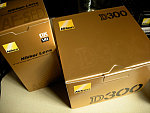 By MIKE PASINI
By MIKE PASINIEditor
The Imaging Resource Digital Photography Newsletter
SAN FRANCISCO -- Dogpatch is a nine-square block of San Francisco not frequented by tourists. It's both too residential and too industrial for the limelight. But it's one of those neighborhoods that make San Francisco what it is -- a delightful surprise on any street.
|
|
And one such surprise is Dogpatch Studios (http://www.dogpatchstudios.com), a recently renovated building that houses print, film and event space. Nikon managed to snag the third floor photo studio with its wall of northern light and view of downtown for an all-day, intensive D300 boot camp.
The event was organized by Nikon's Geoffrey Coalter who managed to drag Nikon's Lindsey Silverman out of his sick bed to explain to a few journalists what's so special about the D300. Joining your newsletter editor were PCWorld Senior Product Manager Melissa Perenson (http://www.pcworld.com), Rick Oldano of the Digital Tourist (http://www.thedigitaltourist.com) and Maximum PC Editor Gordon Mah Ung (http://www.maximumpc.com). Peter Gerba, Dogpatch studio manager, made us all feel at home in the cavernous studio.
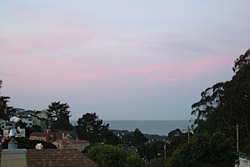
A Perfect Day. So perfect, in fact, the sky blushed. These first shots were taken with a Coolpix S510.
Geoff had promised to include an actual, real live, working professional photographer (not to mention a model). And he delivered as promised with the affable John Blaustein (http://www.johnblaustein.com) of Berkeley. John's clients include such luminaries as J. Walter Thomspon, Hal Riney & Partners, Pentagram Design, Saatchi & Saatchi Direct, Young & Rubicon and Apple Computer, among many others.
We were also enticed to Dogpatch by that promise of a model. The model, alas, turned out to be Rob, a fireman from the fire house next door. Not our cup of tea but quite photogenic all the same. And a pro to boot.
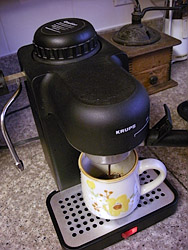
Fuel. We only had time for an espresso.
A PERFECT DAY | Back to Contents
Despite some pretty disastrous weather earlier in the week, the day broke clear. Our 10 a.m. start gave us just enough time to hitch a ride to Dogpatch with our better half, who happens to work just down the street from the studio. After enduring her coworkers' Bring Your Husband to Work Day jokes for an hour, we gathered our gear and found the studio.
Geoff and Lindsay greeted us at the door and introduced us to Peter, Rick and John. We immediately thanked Lindsay for his quick tutorial on Live View mode at the Pepcom event before the Consumer Electronics Show. His five minute overview had demonstrated how we might use the D300 to shoot the Expo. With Active D-Lighting enabled, we were able to complete our photo coverage in much less time than usual, changing the white balance on only two of our dozens of images.
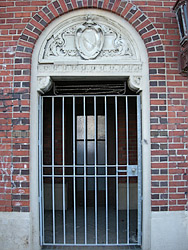
Firehouse. Next door to Dogpatch Studios, a very handy firehouse.
Our arrival had interrupted a discussion about the average life span of a new camera these days. Nikon's first SLR, the Nikon F, was introduced in 1959. The F2 made its debut in 1971. The D200 was introduced in 2006 and, while still available, the D300 elbowed its way onto the scene just a year later. Rick shuddered at the investment a new dSLR must require.
Almost on cue, the rest of the crew arrived and Lindsay took the floor to give us an overview of what's new and improved about the D300. We were all ears -- and eyes.
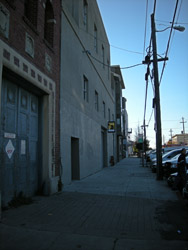
Blue Sky. No rain. Firehouse and Dogpatch Studios buildings.
NEW FEATURES | Back to Contents
Lindsay has been with Nikon for 23 years. His job is to know every feature of every dSLR and Coolpix digicam in the lineup. We can't imagine it's really part of his job to evangelize them, but just try to interrupt him. He knows this stuff and he loves it.
He made a very astute observation about the tendency for pros to stick with what they know. You have to get the job done, so you don't experiment with new features like 51-point autofocus with 3D tracking. Instead, you find the single point autofocus setting (or eschew even that for manual focusing) and get the job done. Just like you always have.
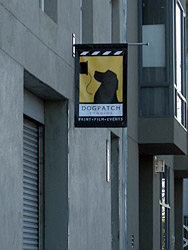
Dogpatch Studio. We didn't know about the elevator.
Uwe Steinmueller of Digital Outback Photo (http://www.outbackphoto.com) is the patron saint of that approach. He shoots in Manual mode because that works on any camera.
But that was one of the reasons for calling this meeting, Lindsay said. Nikon wants to give harried journalists a chance to use these new features. And, of course, write about them.
We confess. Like Uwe, we're in the FM school of photography. Give us an all-mechanical camera like the legendary Nikon FM (no battery will keep us from our appointed rounds) and let us set the shutter speed and aperture manually. We'll get the job done. Focusing manually.
But today's dSLRs are battling each other to the death with intelligence. Sensor size isn't really the game, especially if you're going to print. Ease of use impresses no pro. But give us a feature that lets us get a shot nobody else got and you've made a convert. Or, in our case, let us get to bed before Jay Leno signs off after a day of walking the Expo floor and we'll evangelize for you.
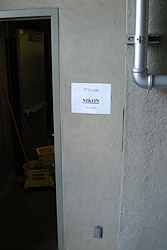
Nikon. Third floor.
AUTOFOCUS REDEFINED | Back to Contents
Nikon's 51-point autofocus with 3D tracking is a case in point. You read about it, you scratch your head, you're maybe a bit embarrassed by your 9-point version (which you don't use anyway, preferring the single point autofocus you know and love), but what the hey.
No, no, no. This is big, Lindsay says. The auto scene recognition built into the D300 can recognize a subject's head and shoulders. So it can track the subject as it moves through space.
"It somehow knows," John confirmed, what (and where) the subject is.
The usual reply to this is, "Sure, most of the time." But who can risk missing the shot autofocus won't get?
But, as John pointed out (affably), the D300 still works like every autofocus camera before you. You can point to the subject and half press the shutter button to focus. You can direct focus.
But you don't have to. If, for some reason, 51 doesn't hit the target you're aiming at, just tap the shutter button a second time. It will refocus.
Well, OK, it was Nikon's donut after all. We set the D300 to 51 point AF and left it there all day. We did not miss a single shot, try as we might. Subject split on either side of the frame? Got it (them, we should say). In fact, we kind of liked seeing all the focus confirmation spots light up every time we half-pressed the shutter button. Suddenly we had an intelligent assistant with us.
We're usually pretty reliable when it comes to screwing things up. But we couldn't trick the 51 point AF into looking at the wrong thing. We tried all day, too.
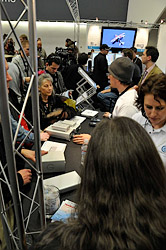
Hand Held Live View. At Macworld. We just aren't this tall.
The D300 features Nikon's first attempt at Live View, which lets you use the LCD rather than the viewfinder to compose your image in real time. The advantage, as with any digicam, is that you can position the camera away from your face, getting a unique (and sometimes the only) angle on the shot.
The problem with Live View technology generally is focusing. With the mirror up, the camera can't focus. This has occasioned some strange camera behavior, flipping the mirror down to focus and then back up to take the shot.
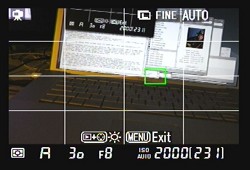
Tripod Mode. You can move the green target anywhere with the multi-selector.
The D300 offers two different Live View modes. One keeps the mirror up and focuses quickly when you fully depress the shutter button. The other focuses with the mirror up -- as long as you're able to keep the camera still.
We used method one with great success for our Macworld Expo coverage and testified before the assembly. Method two really requires a tripod, but we can see using it to get more illuminating product shots.
Being able to experiment with new features isn't just a mind set. Nikon has provided a special menu on the D300 called My Menu that can be populated with the settings you'd like to experiment with (or just the ones you like to change a lot). Having them all on one handy menu makes it easy to enable and disable them.
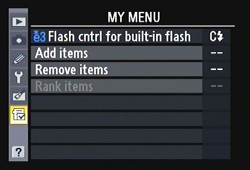
My Menu. Add, remove, rearrange.
You don't have to bother with autofocus modes, of course, because that's just a switch on the back of the camera, easily changed from shot to shot if necessary. That's the beauty of dSLR design to begin with: you have at your fingertips the controls you most often want to change.
The old film rewind crank position, for example, has buttons for image quality, white balance and ISO. Hold in a button and use one of the subcommand dials on the other side of the camera to scroll through the options. Later in the day, we found ourselves switching from NEF/JEG captures to JPEG captures just by scrolling through the image quality options. Piece of cake.
The D300 departs from previous Nikons in using a CMOS instead of a CCD sensor (which apparently makes that 14-bit Raw capture option possible). Whereas before, the highest ISO you could use without risking a disturbing noise pattern was about ISO 800, the new sensor, Lindsay claimed, unleashed him. He can go to ISO 3200 without worry.
We worry about ISO 3200. We worry less at ISO 1600.
But how do you explain that to the D300? Ah, there's a way. If you enable Auto ISO, you can set the base ISO and restrict any increase to the top limit you specify. So we can set the base ISO to 200 (the lowest the D300 offers, although it can simulate lower ISOs if forced to do so) and limit Auto ISO to 1600 max.
The LCD screen will warn you if conditions require the camera to raise the ISO from the base to an Auto setting. And it will tell you what that setting is. And it could be anything, not just whole stops, Lindsay said. You might go from ISO 200 to ISO 230. You can see that in operation if you look at the Exif data for our gallery images accompanying this story.
This is another one of those features we avoid in our prudence. We stick with the lowest ISO speed for the highest quality image. If that won't get us the exposure we want, we gradually ratchet up the ISO until we get the shutter speed or aperture we need.
No, no, no. Let Auto ISO save the day. We set up the D300 to use ISO 200 unless it thought better. And it turned out we had a lot more latitude than we were used to. It's a digicam approach, no question, but with a big sensor the results are a lot more rewarding. Noise wasn't really an issue because we capped the expansion to ISO 1600 (and remember that we had an optically stabilized lens to give us about four stops to play with than normal). We had more latitude with no cost. What had we been thinking?
AUTO WHITE BALANCE | Back to Contents
It's all new on the D300 and D3, Lindsay told us. You know how exposure metering depends on a database of metering patterns to tell if its looking at a landscape with a bright sky or a snow covered meadow? Well, Nikon has a white balance database that works much the same way, with 20,000 examples in its memory.
You can, in short, trust it. Unless you've got 30,000 in your memory.
This really flies in the face of recent wisdom. Recent wisdom suggest that if you know what the white balance of the scene is, you should just tell the poor camera so it can stop worrying about it. Daylight? Shoot daylight and forget it.
Our own feeling about this is that it's hard to tell what lighting we're shooting in. It isn't just our Ray-Bans. Everything seems mixed. This is the one feature we do trust more than our own judgement, perhaps because film gave us little choice. And now we're expected to tell Fluourescent 1 from Fluorescent 2.
John added an interesting, if sheepish, observation to the discussion. "No one ever got in trouble for warming up the daylight." As on the D200, the D300 lets you fine tune even auto white balance. To do it, you hold down the White Balance button on the left of the camera and spin the front command dial. This takes you through a range of settings from a6 to 0 to b6. On the D200 they range from +3 to -3 mired (about 13 degrees K each). What's that all about? Nikon's engineers thought plus and minus would clearly indicate warm or cold when they designed the D200. By the time they were working on the D300, the theory had moved to "amber" and "blue." We're alone with the engineers on this one.
But we took John's advice and warmed up Daylight to a2. That wasn't ideal for scenes of the blue bay or bananas on display in the Ferry building, but it was great for portraits.
HITTING THE STREET | Back to Contents
In fact, that's what we all did next. Hit the street. We climbed into a van and drove down the Embarcadero to a pier near the Ferry Building and walked along taking shot after shot at various settings with our D300s.
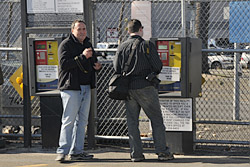
Paying the Pier. John and Geog negotiate with robotic parking lot attendant.
We've posted a selection of our favorites in a special gallery with links to the Exif data.
It's one thing to sit in a cavernous studio in a hip part of town absorbing technical detail. It's another to stumble over the poetry-strewn Embarcardero with a D300 in your hand trying to make photographs under the constant assault of curious seagulls. Fortunately we, too, were traveling in a group.
We asked John, just for fun, if there were certain f-stops we should avoid on the 18-200mm zoom lens. Were we liable to suffer chromatic aberration more severely at f4.5, say, than f5.6? Was f22 too soft?
He sighed. Hey, if f4.5 does what you want, shoot at f4.5. If you need f22, shoot at f22. You can get too caught up in the supposed tradeoffs and miss the effect you want if you don't try it.
Practical advice. And the truth is that we spend so much energy making fine discriminations between one piece of gear and another that we box ourselves in to a narrow, safe set of options that limits us to the same old.
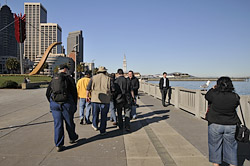
Along the Embarcadero. Peter, Gordon, Rick Lindsay, John, Melissa.
Of course, it doesn't hurt that the D300 automatically corrects for chromatic aberration. "You don't have to turn that on," Lindsay confirmed. It's always active.
Somehow that was liberating. We took some f22 shots that spanned a bay seal just a few yards in front of us and the other side of the bay far way, confident everything would be in focus. And later, in the Ferry Building, we opened the aperture wide to focus on one of a row of bottles of olive oil. We felt free to make extreme choices. Let the camera figure it out.
It figured it out, all right.
FLASH AFTER LUNCH | Back to Contents
After sandwiches, pizzas and DayQuil (well, for Lindsay), we picked up our D300s and popped the flash up. Not to shoot with direct flash, though. No, no, no. We were going to use the flash in Commander mode to control an SB-800 external flash (or two) as we shot Rob, the model.
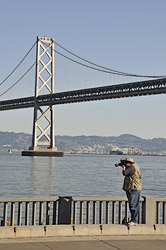
Rick at Work. No toll.
This is, in small scale, Nikon's Creative Lighting System. It turns your pop-up flash into an infrared remote control for any number of external flashes which you can, in turn, organize into one or two groups under the pop-up's control (or three using an SB-800 or SU-800 mounted to the camera's hot shoe).
And when we say remote control, we don't just mean trigger. You can change the volume, not just the channel. Each group of flashes can be set to fire at different outputs and you can control that directly from the camera itself, without visiting each flash in your setup.
To get the hang of this, we started with a single SB-800 bounced into an umbrella to light Rob from the side with a softer light than the direct flash would have provided. Lindsay set up his D300 to wirelessly signal the SB-800 to fire under TTL (through the lens) control so the camera could tell the flash when enough was enough.
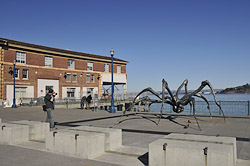
Geoff at Work. Saving the city from a giant spider attack.
He shot in Programmed Auto to start with, looked at the image, copied the aperture and shutter speed settings to Manual mode and made his exposure adjustments.
But the beauty of setting the pop-up flash to Commander mode is that you can ratchet down or up the amount of light the remote flash delivers. And, just to enhance the fun, you can do that for each group of flashes you are controlling.
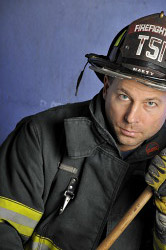
CLS. Two SB-800s on this shot, one from the extreme right and another, less powerful, from the front to fill.
To illustrate that, Lindsay tapped into a VAL (Voice Activated Lightstand) to hold a second SB-800 (without blocking the infrared sensor). Melissa volunteered to be the VAL and Geoff spelled her.
That SB-800 was set up for Group B and configured with a different output than the original Group A SB-800. By adjusting the light output settings on the D300, he was able to adjust the light on Rob's face until he got just what he wanted.
The interesting thing about this process was how much fun it was. We weren't diagramming lighting schemes and measuring flash output with a meter and driving ourselves and Rob nuts. We were really just goofing around. But the results looked like we'd been working.
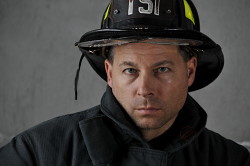
Bounced. John pointed the SB-800 at the huge window shade to the left and we got this effect.
In fact, we all set our D300s to different settings for Group A and Group B. The two flashes didn't mind at all. We took a shot and looked at the results. Too much light from one or the other flash? We just made the adjustment on our D300, without affecting anyone else's adjustment.
We'd take a shot, make a change, take a shot, evaluating the results in that gorgeous 3.0-inch LCD on the D300. And we quickly managed to get something we hadn't planned or even seen, something dramatic that delighted us, just by making a few simple changes to the light output using the camera's menu system.
(Our macro shots of the D300 in our earlier diary entry were shot using the D200 and an SB-800, in fact.)
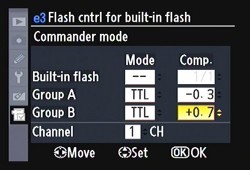
Commander Mode. We've set the built-in flash off, Group A to be -0.3 EV measured through the lens and Group B to be +0.7 EV measured through the lens, all on channel 1.
John was impressed. It was a lot easier than it sounded, which is probably why Nikon calls it the Creative Lighting System. There's really nothing quite like it.
While it may not surprise you that shooting a fireman can burn you out, we found ourselves collapsing mid afternoon into actual chairs. John fired up his computer to demonstrate how Nikon's TransferNX and ViewNX help streamline a workflow.
Here too we have different methods. But we have to admit an attraction to ViewNX at least. We're charmed it can display the focus points on the images but we also like the layout. What we miss from our aging iView MediaPro is the ability to rotate the image data (and copy images to other folders). Lindsay didn't think we really needed that (it was a defect of our applications) but that was the DayQuil talking. We need it to get images correctly oriented for the Web where Exif headers and orientation tags are meaningless.
Almost inadvertently (as these things happen), we stumbled on a discussion of how to evaluate apparent image sharpness.
It's no small problem for us. As we evaluate 10 and 12 megapixel sensors we seem to be seeing less and less sharp images. But they should, by all reasonable indicators, be delivering higher resolution. And our resolution chart looks pretty sharp with these high resolution sensors. Why the contradiction?
Turns out this had puzzled Lindsay too. When he asked Nikon engineers about it they suggested the problem was really one of scale. When you look at a 12-Mp image on your screen at 72 dpi, you have your nose to the glass at the candy store and are fogging the window.
To properly evaluate 10-Mp images and larger on your screen, they suggested, you should view them at 50 percent rather than 100 percent.
We'll have to try that.
SENSOR CLEANING | Back to Contents
Time flew (we were having fun) and before we knew it, it was time for dinner. We all jumped in the van and parked right in front of the place. Bacar (http://www.bacarsf.com) provided a comfortable table for us to finish the day discussing sensor cleaning and archiving.
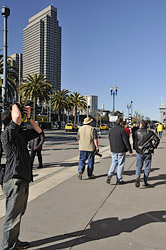
The D300 Gang. Geoff, Rick, John, Lindsay.
Not one of us really does either task the same way. That was refreshing.
The sensor cleaning discussion was amusing. We, like Lindsay, use a blower when necessary. But he uses it to blow debris off the sensor cover while we use it to such the dust off. We're fortunate in having pretty good control over the environment where we change lenses (that bunker of ours, usually), so we haven't had to deal with the problem much.
But John has. He uses Copper Hills (http://www.copperhillimages.com/index.php?pr=Tutorials) wet cleaning solution, which is what the lab guys at Imaging Resource rely on. For those trips where you can't bring your kit, we suggested Dust-Aid (http://www.dust-aid.com), a very simple adhesive-based product. It's something you can take on an airplane, it's a dry not wet method and it gets the corners just as well as the middle of the sensor cover.
We all agreed that the less cleaning, the better. And the less intrusive, the better, too.
The least intrusive on the D300, however is its anti-dust feature. The D300's anti-dust feature can be set to vibrate the low-pass filter in front of the sensor when you turn the camera on, off, both time or on demand.
The D300 can also take a dust reference photo that Capture NX can use to retouch Raw captures. That would be our least favorite alternative, of help only after the fact.
We all archive. Let there be no mistake about that. But we all find it overwhelming, too. Melissa, who brought up the subject, said she can easily come home from shooting athletic events with 16-GBs of images.
We talked about the Drobo (http://www.drobo.com) from Data Robotics, but it had some issues for Melissa. While you can mix and match drive sizes, its capacity is determined by the capacity of the smallest hard drive you install. And the file system is something of a mystery, she said. You can't just pull out a drive, stick it in an external enclosure and be able to read your files.
External drives were the device most relied on, of course, but Melissa wondered if they would spin up if left on a shelf for a couple of years. Or, we wondered, if their electronics would need firmware updates to be compatible with modern busses.
In the end, we recommended renewing your archive every few years on new media. It may seem like your archiving your archive, but it's really just a way to keep it fresh.
PARTING COMPANY | Back to Contents
We reluctantly said goodbye to our colleagues at the curb and jumped on a bus to get home in time to get the newsletter draft done. It was also hard to put the D300 down (and we have no idea how we'll bring ourselves to part with it when the loan period is up). It's not just a rethinking of what we loved about the D200, it's a better camera in the same box.
We may have to change our identity and leave the country for a while to hang on to it until the D400 arrives some stormy November.